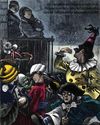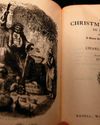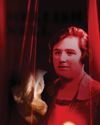
"Nearer and nearer creeps this terrible inferno which only ends in death. May it come quick and mercifully." So wrote Sergeant Horace Reginald Stanley in his diary while serving at Ypres in 1915. "Some poor wretch has the side of his skull blown away and it is obvious nothing can be done for him. Oh the horror of it all." Sergeant Stanley's testimony remains a shocking, uncomfortable read - even from the distance of 108 years. Yet there was nothing particularly extraordinary about it. For countless soldiers - eating, sleeping, fighting and often dying at the edge of no-man's land- such horrors would have been all-too familiar. Trench warfare is surely the defining characteristic of World War I. As anyone who's watched Blackadder or All Quiet on the Western Front will attest, when we think of the 1914-18 conflict, our minds invariably turn to what soldiers were forced to endure in the trenches.
SELF-PRESERVATION
There was nothing new about trench warfare when World War I erupted in 1914. Recent conflicts - the American Civil War and Russo-Japanese War among them all pointed to trenches becoming the default for armed struggles between large, industrial powers unable to land rapid knock-out blows. With new technologies such as powerful artillery and rapid-fire machine guns enabling defenders to cut down attackers with terrifying efficiency, military planners in 1914 were painfully aware that their armies would probably have to head underground in the interests of self-preservation.
This story is from the {{IssueName}} edition of {{MagazineName}}.
Start your 7-day Magzter GOLD free trial to access thousands of curated premium stories, and 9,000+ magazines and newspapers.
Already a subscriber ? Sign In
This story is from the {{IssueName}} edition of {{MagazineName}}.
Start your 7-day Magzter GOLD free trial to access thousands of curated premium stories, and 9,000+ magazines and newspapers.
Already a subscriber? Sign In

'Dickens's evocation of the fears, excitement and confusion of childhood is peerless'
DR LEE JACKSON ON WHY CHARLES DICKENS REMAINS RELEVANT TODAY

THE AUTHOR GOES ABROAD
Dickens expanded his horizons and boosted his fan-base by venturing overseas - but global fame came with a cost

REVIVING THE FESTIVE SPIRIT
A Christmas Carol wasn't just a bestseller - it changed the way that Britons chose to mark the festive season

GIVING THE POOR A VOICE
From Hard Times to Oliver Twist, Charles Dickens used his pen to help illuminate the lives of the less fortunate

A JOURNEY THROUGH DICKENS'S LONDON
The works of Charles Dickens are synonymous with visions of Victorian London. We talk to Dr Lee Jackson about the author's love of the capital, and the locations that most inspired him

EXCEEDING EXPECTATIONS
Dr Lee Jackson chronicles Charles Dickens's journey from down-at-luck teenager to titan of Victorian literature

GIFTS, TREES & FEASTING
We take a journey through the photo archives to reveal how Christmas and its many traditions have been celebrated over the years - and around the world

WHAT GREAT PAINTINGS SAY
We explore the story behind an allegorical painting that celebrates the triumph of love over hate, peace over war

HELLISH NELL
Malcolm Gaskill delves into the life of Helen Duncan - the fraudulent Scottish medium whose ectoplasm-filled seances saw her ending up on the wrong side of the law

7 THINGS YOU (PROBABLY) DIDN'T KNOW ABOUT THE WHITE HOUSE
Presidential historian Dr Lindsay M Chervinsky reveals some of the most surprising facts about the world-famous US residence